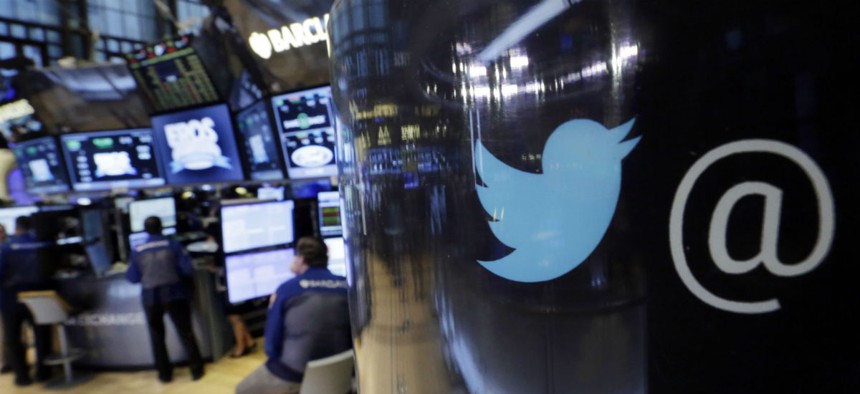Twitter Suspends Another 235,000 Accounts Promoting Terrorism

Richard Drew/AP
ISIS is losing territory online, too, as Twitter joins social media companies accelerating efforts to purge extremist speech from their sites.
Twitter has doubled its efforts to purge extremist content from its site since April, bringing the total number of accounts suspended to 360,000 since the middle of 2015, the company announced Thursday in a blog post. That should greatly reduce the Islamic State’s ability to reach out to potential followers and distribute its propaganda, according to experts.
The move follows Twitter’s previous announcement it was suspending 125,000 accounts “for threatening or promoting terrorist acts primarily related to ISIS.”
“Today, we are announcing that we have suspended an additional 235,000 accounts for violating our policies related to promotion of terrorism in the six months since our February 2016 post,” the company reported. The company also said daily suspensions were up 80 percent as screeners move more quickly to stop extremist posts.
“Our response time for suspending reported accounts, the amount of time these accounts are on Twitter, and the number of followers they accumulate have all decreased dramatically," according to Twitter. "We have also made progress in disrupting the ability of those suspended to immediately return to the platform. We have expanded the teams that review reports around the clock, along with their tools and language capabilities. We also collaborate with other social platforms, sharing information and best practices for identifying terrorist content.”
Twitter stepped up efforts to push ISIS off its networks after the widow of Lloyd “Carl” Fields Jr., a U.S. contractor killed by ISIS, filed a suit against the company in January, claiming Twitter was partially responsible for the death because it provided a means for ISIS to recruit and raise funds for terrorism in violation of the Anti-Terrorism Act. Twitter argued the platform was neutral and that it bore no direct responsibility. The company won the suit earlier this month.
Twitter Suspensions: Whack-A-Mole … With a Finite Number of Moles
How many ISIS supporters are on Twitter anyway and do the suspensions do any good?
In March 2015, author J.M Berger and data scientist Jonathon Morgan estimated as many as 90,000 ISIS supporters could be on Twitter. Once purged, many users quickly rejoin Twitter under new names.
Research by Berger, however, shows the suspensions add to the costs of doing business for groups like ISIS. Once an account with many followers is suspended, a new account created by the same user is unlikely to ramp up to the same number of followers.
“For instance, in 2013, al Shabab’s Twitter account was suspended. It returned, but the new account never recovered its substantial follower base. After multiple suspensions, al Shabab surrendered and stopped creating new accounts, except sporadically. In 2014 and 2015, in a similar manner, Twitter suspensions effectively denied use of the platform to ISIS’ official accounts. These accounts are key to the dissemination of official propaganda, and they provide a critical structural anchor for online recruitment efforts,” Berger writes in this research paper from May.
Other social media companies such as Facebook and YouTube are employing automation and machine learning to spot and tag extremist content (pictures and video) before it spreads, thanks to a program led by the Counter Extremism Project, a nonprofit group that bills itself as a clearinghouse of research on extremist groups. Twitter has been the holdout. In March, it said there is no “magic algorithm” for identifying extremist content.
Twitter also said it was seeking additional partnerships with nongovernmental organizations around the world to counter extremist content. The company said it is willing to work with U.S. law enforcement “entities seeking assistance with investigations to prevent or prosecute terror attacks. Twitter responds to valid legal process issued in compliance with applicable law as explained in our Law Enforcement Guidelines, and we report on these government requests (in aggregate) twice a year, in our Transparency Report.”
The company has been wary of looking too cozy with the United States government. In May, an intelligence official told The Wall Street Journal Twitter had barred the intelligence community from accessing Dataminr, a service that analyzes Twitter’s stream public tweets to spot emerging trends.
But Twitter, the U.S. government and various nongovernment nonprofits around the world continue to share the overall goal of seeing ISIS gone from Twitter.
In June, Michael Lumpkin, the director of the State Department’s new Global Engagement Center to combat extremism online, (which pulls talent from the Pentagon and the intelligence community), described his relationship with social media companies including Twitter as good.
“It’s a sound business decision for them, right?” he said of the previously announced suspensions. “The last thing that they want to do is be branded … That for some reason they were doing something wrong. I will tell you that I have found industry to be very easy to work with.”






